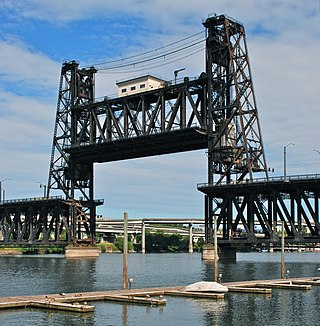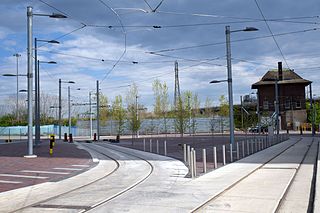
Light rail transit (LRT) is a form of passenger urban rail transit characterized by a combination of tram and rapid transit features. While its rolling stock is similar to a traditional tram, it operates at a higher capacity and speed, and often on an exclusive right-of-way. In many cities, light rail transit systems more closely resemble, and are therefore indistinguishable from, traditional underground or at-grade subways and heavy-rail metros.

The Steel Bridge is a through truss, double-deck vertical-lift bridge across the Willamette River in Portland, Oregon, United States, opened in 1912. Its lower deck carries railroad and bicycle/pedestrian traffic, while the upper deck carries road traffic, and light rail (MAX), making the bridge one of the most multimodal in the world. It is the only double-deck bridge with independent lifts in the world and the second oldest vertical-lift bridge in North America, after the nearby Hawthorne Bridge. The bridge links the Rose Quarter and Lloyd District in the east to Old Town Chinatown neighborhood in the west.

The Hamilton Street Railway (HSR) is the public transport agency for Hamilton, Ontario. The name is a legacy of the company's early period, when public transit in Hamilton was primarily served by streetcars. Although streetcars are no longer used in the city today, the HSR operates bus and paratransit services, with a ridership of 21 million passengers a year. The HSR uses the Presto card as its method of fare payment, allowing for connections with GO Transit and other transit systems in the Greater Toronto area.

The Edmonton Transit Service (ETS) is the public transit service owned and operated by the City of Edmonton in Alberta, Canada. It operates Edmonton's bus and light rail systems. In 2022, the system had a ridership of 68,829,300, or about 279,600 per weekday as of the second quarter of 2023.

The Toronto streetcar system is a network of ten streetcar routes in Toronto, Ontario, Canada, operated by the Toronto Transit Commission (TTC). It is the third busiest light-rail system in North America. The network is concentrated primarily in Downtown Toronto and in proximity to the city's waterfront. Much of the streetcar route network dates from the 19th century. Most of Toronto's streetcar routes operate on street trackage shared with vehicular traffic, and streetcars stop on demand at frequent stops like buses. Since 2019, the network has used low-floor streetcars, making it fully accessible.
Various terms are used for passenger railway lines and equipment; the usage of these terms differs substantially between areas:

Light rail is a commonly used mode of public transit in North America. The term light rail was coined in 1972 by the Urban Mass Transportation Administration to describe new streetcar transformations which were taking place in Europe and the United States. The Germans used the term Stadtbahn, which is the predecessor to North American light rail, to describe the concept, and many in UMTA wanted to adopt the direct translation, which is city rail. However, in its reports, UMTA finally adopted the term light rail instead.

Streetcars or trolley(car)s were once the chief mode of public transit in hundreds of North American cities and towns. Most of the original urban streetcar systems were either dismantled in the mid-20th century or converted to other modes of operation, such as light rail. Today, only Toronto still operates a streetcar network essentially unchanged in layout and mode of operation.
Transport in Edmonton is fairly typical for a Canadian city of its size, involving air, rail, road and public transit. With very few natural barriers to growth and largely flat to gently rolling terrain bisected by a deep river valley, the city of Edmonton has expanded to cover an area of nearly 768 km2 (297 sq mi), of which only two-thirds is built-up, while the metropolitan area covers around 9,430 km2 (3,640 sq mi).

The Dudley B. Menzies Bridge is a dedicated LRT bridge crossing the North Saskatchewan River in Edmonton, Alberta, Canada. Named after Edmonton engineer and politician Dudley Blair Menzies, the bridge was the "first concrete segmental box girder bridge in Western Canada". The main deck carries two tracks of the LRT system connecting Government Centre station and the University station. A walkway for pedestrians and bicycles hangs beneath the main spans of the bridge over the river.

The Low Level Bridge is a bridge that spans the North Saskatchewan River in Edmonton, Alberta, Canada. Completed in 1900, this was the first bridge across the North Saskatchewan River. It was designed to carry a railway, and a railway track was added in 1902 to accommodate the Edmonton, Yukon and Pacific Railway.
Transport in Saskatchewan includes an infrastructure system of roads, highways, freeways, airports, ferries, pipelines, trails, waterways, and railway systems serving a population of approximately 1,098,352 inhabitants year-round.

The Walterdale Bridge is a through arch bridge across the North Saskatchewan River in Edmonton, Alberta, Canada. It replaced the previous Walterdale Bridge in 2017. The new bridge has three lanes for northbound vehicular traffic and improved pedestrian and cyclist crossings.

The Edmonton Radial Railway Society (ERRS) restores and operates historic streetcars in Fort Edmonton Park and across the High Level Bridge. It is named after the Edmonton Radial Railway, which began service in 1908 and later became Edmonton Transit Service.

The Edmonton Radial Railway (ERR) was a streetcar service that operated in Edmonton, Alberta, from 1908 to 1951. It was Edmonton's first public transit service, and later evolved into Edmonton Transit Service. Beginning as a small agency with 21 kilometres (13 mi) of track and four streetcars, the ERR would eventually operate more than 70 streetcars on over 90 kilometres (56 mi) of track, reaching most areas of the city. At its peak in 1929, the ERR served more than 14.1 million passengers.

105 Street is an arterial road in Downtown Edmonton, Alberta, Canada. It starts across the North Saskatchewan River from Downtown, as one-way streets Walterdale Hill and Queen Elizabeth Park Road, which join and continue north on Walterdale Bridge. At 100 Avenue, 105 Street becomes a two-way street, and continues through Downtown past MacEwan University.

The Williamsburg Bridge Plaza, sometimes called Washington Plaza or the Williamsburg Bridge Transit Center, is a major bus terminal and former trolley terminal located at the foot of the Williamsburg Bridge in the New York City borough of Brooklyn, one block west of the Brooklyn-Queens Expressway (I-278). It is situated by the boundaries of Broadway, Havemeyer Street, Roebling Street, and South 5th Street, south of the LaGuardia Playground. It contains five bus lanes, and serves as a terminal for numerous MTA New York City Transit Authority bus routes of Brooklyn and Queens that start and end their runs there.

Beginning operation in 1861, the Yonge streetcar line was the first streetcar line in Toronto and the first in Canada. It started off as a horsecar line and closed in 1954 operating two-unit trains of Peter Witt motors pulling a trailer. Under the Toronto Transportation Commission, the Yonge line was the busiest and most congested streetcar line in the city leading to its replacement in 1954 by the Yonge Subway line, also Toronto's first and the first in Canada.
Calgary Trail and Gateway Boulevard are a pair of major arterial roadways in Edmonton, Alberta. Gateway Boulevard carries northbound traffic while Calgary Trail carries southbound traffic. From south of 31 Avenue, they form a two-way freeway separated by a median; for this portion, the roadway maintains the separate names for northbound and southbound traffic. Near 31 Avenue, Calgary Trail and Gateway Boulevard separate and become parallel one-way arterial roadways to Saskatchewan Drive, at the edge of the North Saskatchewan River valley. Designated as part of Highway 2 south of Whitemud Drive, it is Edmonton's main southern entrance and is both a major commuter route, connecting to the Edmonton International Airport and Leduc, as well as a regional connection to Red Deer and Calgary.

Distillery Loop is a streetcar loop in the Toronto streetcar system in Toronto, Ontario, Canada that lies at the south end of the Cherry Street branch – originally dubbed the Cherry Street streetcar line – that runs from a streetcar junction on King Street East south along Sumach and Cherry Streets. The loop opened in June 2016 and is some of the newer streetcar infrastructure in the city. The Cherry Street branch is currently served by the 504A King streetcar route which has its eastern terminus at Distillery Loop.




















